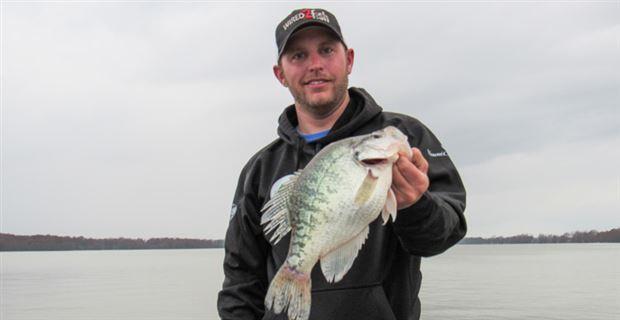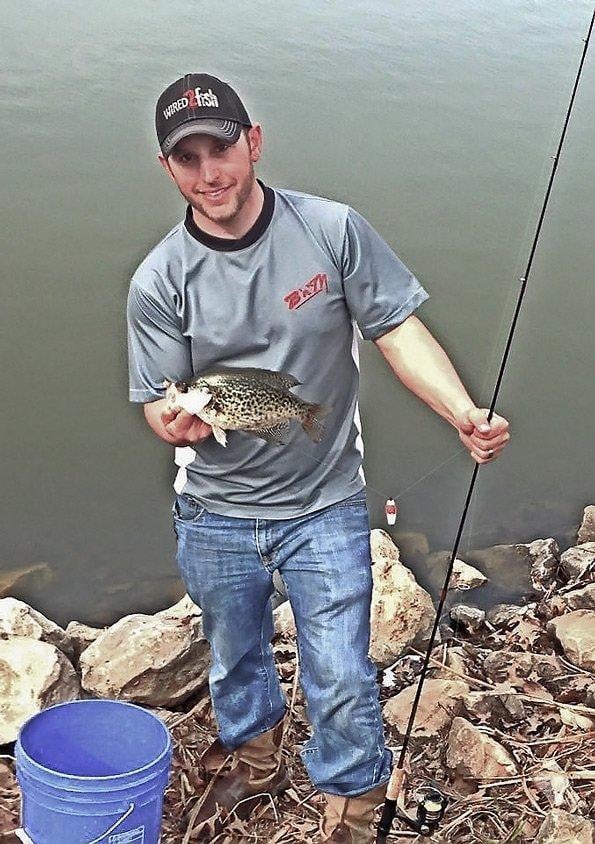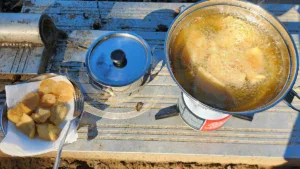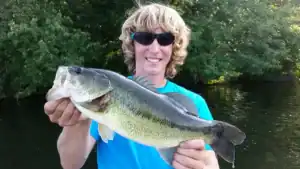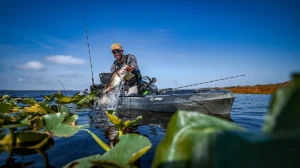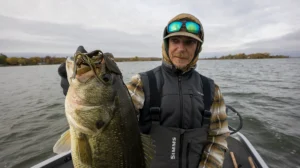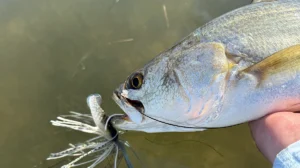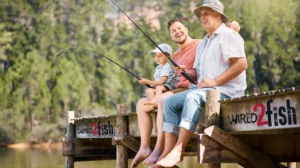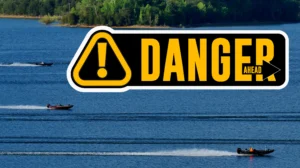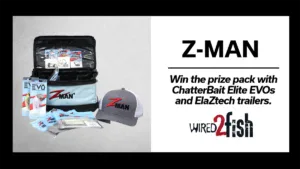Fishing the bank for crappie can be an exciting and productive way to fill a freezer. It doesn’t require a lot of money or fancy equipment, but knowing how, when and where to target crappie from the bank helps. You don’t have to own a nice boat and the latest electronics to bring home a mess of slabs.
The 3 techniques that are most productive for crappie fishing from the bank include the following:
- Dipping the cover
- Casting for slabs
- Bobber fishing
Dipping the cover
Crappie fishermen spend more hours on or near the water during spring than any other time of year. The spawn brings crappie into the shallows near cover, and bank fishermen have a distinct advantage on some lakes and rivers.
Vertical jigging, or “dipping,” shallow cover is easily done from the bank with a long rod and a jig. Before easing up to the water’s edge, stand back and probe the water closest to the bank. Crappie can spawn in as little as 8-inches of water, and depending on the slope of the bank, they may be within a foot of dry ground. Work the area thoroughly while slowly moving forward and reaching out further to deeper water. Laydown trees and bushes are excellent places to find crappie during this time of year.
When fishing thick cover like buck brush, hold your rod in one hand and your line in the other and pull your jig to the tip of pole. This allows you to thread your bait through the heaviest brush and drop your jig slowly into the water. Proper hooksets require the same two-handed technique when in thick cover, and yanking your line with your hand is the best way to get your hook firmly into the top of the crappie’s mouth and begin pulling them out.
Best seasons for dipping: Spring and Fall
Cast and retrieve
Casting and retrieving jigs and small crankbaits can be another effective technique to catch crappie, and especially on small water. Crappie that live in small lakes and ponds are generally easier to catch due to insufficient food, and are more apt to chase anything that they think will fit in their mouth. Casting a Roadrunner jighead with a curly tail and reeling at a medium pace will often trigger strikes from hungry crappie.
During the summer months crappie are more apt to chase larger, louder baits retrieved at a faster pace. Small crankbaits are ideal for catching summertime slabs in open-water ponds or small lakes. Crappie will suspend shallower during the summer due to the lack of oxygen at greater depths, so shallow-running crankbaits are best.
Best seasons for casting: Spring, Summer, and Fall
Bobber fishing
Few successful bank fishermen are without a handful of assorted floats. Casting a cork above a small jig offers the advantage of having exact depth and speed control of your bait. When crappie suspend high in the water column it can be difficult to cast and retrieve a jig without your bait either being below them or moving too fast, unless you employ a float. Experimenting with depth and speed is key to figuring out the bite.
Fishing live minnows beneath a float is probably the most common tactic used by bank fishermen. A split shot 6-inches above a light-wire crappie hook, hooked through a minnow’s lips and fished stationary under a float will entice even the most finicky of fish. Crappie feed up for the most part, so it’s better to fish too shallow than too deep when setting your float.
Best seasons to bobber fish: Spring, Fall and Winter
Tackle recommendations
Bank fishermen do not have the luxury of stuffing 4 tackle boxes and 6 storage compartments full of every jig known to man, nor can they carry 24 different rods and reels for any situation that may occur, but fortunately they don’t need to lug a load of tackle to catch crappie. While landlocked anglers don’t need the variety of gear that can be used from a boat, they do need the right gear.
Vertical jigging cover from the bank is arguably the most exciting way to crappie fish, but without the right equipment it can be the most frustrating. A long, 10 to 12-foot jig pole is the norm for dipping shallow cover, but bank fishermen have to get the crappie through the brush and to the bank without the help of a net or a boat. While finesse is important while easing up to the water and slipping your bait down through the brush, once the hook is set, poise and grace are out the door.
A strong rod with plenty of backbone is a must, because fighting your way back through the brush with an angry crappie in tow is much more difficult than getting there in the first place. Line weight is no different, it needs to be much heavier than what you might use fishing from a boat. Braided line is the best choice, but if cost or availability is an issue, 10-pound mono will do the trick. Cover-oriented crappie, especially during the spawn, are much less likely to pay attention to line diameter than suspended fish, but without enough line strength landing those fish can prove very difficult.
A feather or plastic jig in 1/16-ounce is the norm for dipping tight cover. When the spawn is on or the crappie are actively feeding, color and scent are less important. Black and chartreuse is always a good starting point, and adding a scented attractant will help when the bite is light.
Casting and retrieving to open-water crappie does not require the brute force that jigging in heavy cover does, but it’s still better to have a little more than a little less. 6 to 8-pound test mono will handle any crappie as long as you have a proper drag. A spinning reel allows for farther casts with lighter baits, and has a drag that can be set and easily adjusted mid-fight. A 5 to 6-foot spinning rod will suffice for this tactic, and ultralight to light rods will be more sensitive and detect lighter bites.
A Roadrunner jighead that comes equipped with a blade adds flash and vibration. A curly tailed jig pulled at varying speeds, along with the flash and vibration is deadly combination. Color choices are endless, but a blue or green (or junebug) and chartreuse is a good place to start.
Bobber fishing for crappie can take on many forms, but the two most common methods are casting out and slowly retrieving, or using a long pole with a moderate length of line and flipping out the float and letting it sit. Both methods require a rod with decent backbone to get a firm hook-set.
Casting a float above a jig or minnow can best be done with a spinning reel and a light to medium-light rod. The only difference with regards to equipment, between casting with or without a bobber is rod strength and length. Float fishing often leaves some amount of slack in your line, add to that having to see the bite and react as opposed to feeling a bite, and a stiffer, longer rod will increase your hookup ratio. A 6 to 7-foot light, but not flimsy, spinning rod and a small to medium spinning reel will aptly serve both purposes.
A slip float will slide down to the jig and allow for easier casting, especially when fishing over a few feet deep, or when branches are above you. If fishing shallow and covering water is the ticket, a weighted float will allow you to cast much farther with a light jig. Hang your intended bait from a float at home in the bathtub or sink and note how it sits in the water, how easily it is pulled under, and what it looks like when the jig is lifted up. Having the proper size float that is easily pulled under, and knowing what it looks like when the bait is lifted will help you detect bites from the water’s edge.
Jig choices are endless, but matching the speed of your retrieval to your bait is important when casting a float. A 1/16-ounce jig head and a tube or stinger-tail plastic is perfect for a slow retrieve, and thin curly tail bait is better for a quicker retrieve. A crappie nibble or some type of scented attractant never hurts either.
Flipping or swinging a float above a split shot and minnow is the oldest form of crappie fishing. Many a cane pole have laid across a muddy bank while anglers anxiously await any sign from their bobber that their suspended minnow is in danger.
While a cane pole, heavy line and an oversized bobber are tried and true tools, a telescopic fiberglass rod with a small panfish reel will work as well. The key to this tactic is not to have too much line between your rod tip and bobber, so that when the float disappears, one swoop upwards will both hook the crappie and bring it closer to the bank where it can be landed.
When fishing a float stationary, a live minnow is impossible to beat. A small splitshot that will hold your bobber half in the water and half above should be placed 6-inches above a No. 2 light-wire hook. Hook the minnow through the lips for maximum action and to prolong its life.
Catching crappie from the bank can be a blast, and with the right gear and a little know-how, you can fill the freezer without stepping foot onto a boat!
